Hellebore: description, types, planting and care rules

An amazing perennial plant from the buttercup family - hellebore. Despite his unusual beauty, he is a rather rare guest in the gardens of Russians. Nevertheless, lovers of this plant grow it not only for beauty, but also to restore health. Since the time of Avicenna, hellebore has been used in folk medicine, but since the plant is poisonous, and knowledge about its use was not available to everyone, interest in it was lost. Recently, however, the former glory of the hellebore has once again revived attention to him.
Although now this plant is mainly appreciated for its decorative effect and unusual ability to bloom in November or even January.

Description
Helleborus - this is the Latin name for hellebore, and also its sometimes called the winter house or the "Rose of Christ"because it pleases with its flowering in the winter months. In nature, the distribution area of hellebore is the mountainous regions of the Mediterranean countries, as well as the Balkans and Asia.

The hellebore can grow from 20 to 50 cm and looks like a compact herbaceous bush. The stem of all hellebores is absent, leaves and peduncles grow from the area of the root rosette, but the root system is highly developed, although it does not reach deep bedding in the soil. The herbaceous bush has multiple leaves with a dark green color, they are dense and leathery to the touch, have a long petiole at the base, and are dissected in shape.

The hellebore flower can be of various colors - it all depends on its variety, now there are at least 22 varieties.
The shape of the flower has a cup-shaped structure, the petals are multiple, rounded, in some varieties they can be double, but in fact they are sepals of the flower, and the true petals are transformed into nectaries. The buds form at the top of the stem. Florists love this plant because its flowering begins very early, when the snow has not yet completely melted and the grass has not grown. This is explained by the high resistance of the plant to cold temperature conditions and lack of moisture.

Types and varieties
The appearance of a plant depends on its variety. To date, breeders have bred a variety of hybrid forms by crossing, some of which still do not have a name.

Here are the most common varieties of hellebore known in Russia.
Black
Helleborus Niger is a black hellebore, it got its name from the fact that its massive, but short root is black in color. But the flowers of this species are white or white-pink. The black hellebore varieties have hybrid varieties called Helleborus Nigristern and Helleborus Nigercors.

The black hellebore is considered not only the most popular, but also one of the most beautiful species.
This evergreen perennial grows no more than 30 cm in height and can live without transplanting in one place for at least 10 years. The flowers of such a plant are quite large - with full disclosure, their diameter reaches 7-8 cm, while the peduncles stretch up to 30-50 cm. It is noteworthy that in black hellebores, flower stalks look up, and do not bend down, like in most other species. The flowering period begins in early April and lasts 12-14 days. At the end of flowering, fruit ovaries with seeds are formed on the flowers.

The leaf plates of the flower are dense, as if made of leather, have a beautiful dark emerald color. Their lifespan lasts until the moment of flowering, and then the leaves slowly begin to die off, but in the spring they are replaced by new and fresh specimens. The plant copes well with winter frosts and can survive cold down to -35 ° C.
The agrotechnology of its cultivation is not the simplest, since the flower needs to be constantly loosened and fertilized, in addition, the black varieties of hellebore are often invaded by slugs and snails.

Double Ellen Pink
Helleborus Double Ellen Pink is a hellebore variety with pink pearlescent double petals. The flowers are large, up to 6-7 cm in diameter, located on high peduncles. The plant can reach a height of 35-40 cm, flowering begins in late April - early May. Even clay soil is quite suitable for growing this perennial, but it needs to be dug well with a lot of humus.

In the garden, Double Ellen Pink can be planted in shady areas next to shrubs and garden trees. The hellebore can tolerate long dry periods well, but if it grows on the sunny side, then regular watering is important for it.
Frost resistance allows herbaceous shrubs to tolerate winter well, and it is not required to cover the plant for wintering.

Caucasian
Helleborus causasicum - sometimes called Altai or Siberian hellebore. This evergreen perennial grows up to 30-50 cm, its roots are thin and elongated, have a brown color. Peduncles grow very long, and on them there are flowers with a diameter of 7-8 cm drooping downwards. The petals are not bright, painted in a whitish-green or brown-green hue.
The Caucasian hellebore is considered the most poisonous among all its fellows, but it is this species that is most valued in folk medicine because of its wide spectrum of action.
The flowering period of the plant begins in the third decade of April and lasts until the end of May.

It is noteworthy that the foliage of this perennial retains its green color not only in summer, but also in the winter months. Flowering at the Caucasian hellebore begins in December, depending on climatic conditions, flowering specimens can be found until April. This wild species is currently in need of conservation measures, as due to high demand it is ruthlessly exterminated in large quantities.

Abkhazian
Helleborus abchasicus grows wild in the Transcaucasus. A perennial can grow from 30 to 50 cm in height, its flowers are red or dark pink, their diameter is quite large - 8 cm. In the Abkhaz hellebore, the color of the leaves can combine green and purple shades, and the flower stalks are dark purple in color and grow up to 40 cm.The first buds of this type of hellebore appear in late April or early May, the fruits are formed in mid-summer. The flowering period is quite long and is about 6 weeks.
The Abkhaz wild-growing hellebore also has garden cultural forms that appeared due to selection work.
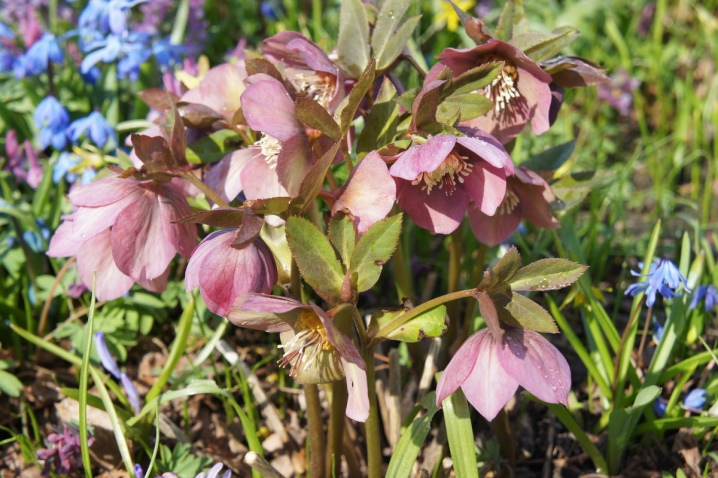
Oriental
Helleborus orientalis is an evergreen perennial, sometimes also called Chinese. It is not very large and its herbaceous bush does not exceed 30 cm. Blossoming in the Eastern hellebore begins in the first decade of April, the flowers are medium in size, but their color can be white, cream, mauve.

This wild species has many hybrid varietal forms. Here is some of them.
- Helleborus Pink Spotted Lady - grows up to 40-45 cm, blooms in early April, has flowers with a delicate pinkish-white color, reddish small spots are located in the center of the inflorescence;

- Helleborus red lady - the height of the bush reaches 40-45 cm, the beginning of flowering is early - from March to May, the flowers are large, reach a diameter of 8-10 cm, their color is dark purple;

- Helleborus Double Ellen Purple - at a height of 30-40 cm, abundant flowering begins in April, the flowers have a double structure, their color is lilac-purple, sometimes even resembles black, it looks very impressive;

- Helleborus Blue Metallic Lady - plant height can be from 25 to 50 cm, flowering occurs at the end of April, flowers are medium-sized, goblet, lilac-purple in color with a pronounced blue tint;

- Helleborus Double Ellen Picotee - a compact bush grows up to 30 cm, medium-sized flowers reach up to 5 cm in diameter, the structure of the inflorescence is terry, the color can be light purple, pale pink, white, but always with a contrasting border along the edges of the petal.

The oriental species also includes hybrid varieties Helleborus Anemone Picotee, Helleborus Yellow Lady, Helleborus Pink Spotted Lady, Helleborus Tricastin, Praecox and others.



Smelly
Helleborus Foetidus - its basal shoots have a small growth, only 20-30 cm, it leaves for the winter with green leaves. During the flowering period, the peduncles form multiple inflorescences, consisting of small flowers, resembling a drooping bell in shape. The color of the flower is greenish, the petals have a reddish-cream border. The stinky hellebore grows in the wild in European forests and is highly resistant to lack of moisture.
Despite its beauty, the flower has a pungent and unpleasant smell for humans. Stinky Hellebore blooms on Christmas Eve.

Corsican
Helleborus Argutifolius grows up to 50-60 cm, loves shaded places and does not have as strong frost resistance as its counterparts - it can withstand temperatures down to -20-23 ° C, therefore, for wintering, it needs shelter with spruce branches. Flowers of yellowish-green color are located on peduncles in multiples and form large flowing brushes. The diameter of each flower reaches 5 cm. The Corsican hellebore is an evergreen plant that retains its decorative properties all year round.

This species blooms early, by the end of January you can see the first buds on it, which continue to form until April. This perennial grows wild and is found in the mountainous regions of Corsica and Sardinia. The herbaceous bush tends to grow rapidly in width.

Reddish
Helleborus purpurascens is a compact perennial plant that grows up to 30 cm. The leaves are collected in a basal rosette and have a great length of up to 25 cm. On the outside, the leaf plates are green, and the inside is painted in a pale green tint. In an adult plant, during flowering, up to 7 peduncles are formed, on them - no more than 3 buds. Flowering begins in late March - early April and lasts up to 4 weeks. The flower is reddish-purple in color and reaches 4 cm in diameter when unfolded.
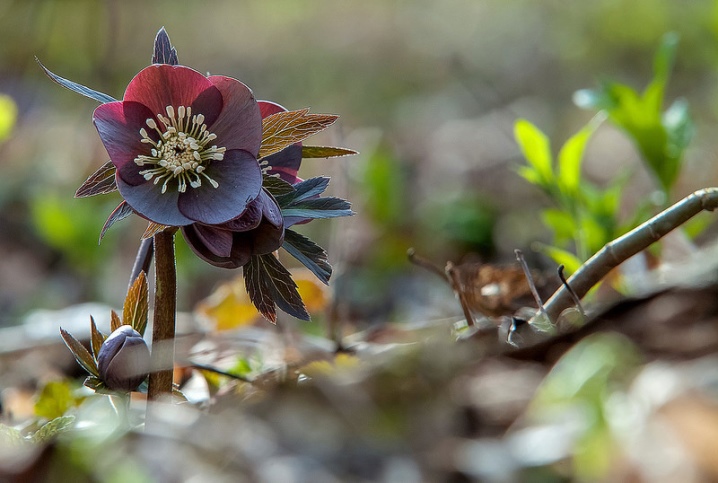
The reddish hellebore is found wild in the forests of southern and eastern Europe, where it is harvested in large quantities. The flowering of a young plant begins only at the age of 4 or 5 years. On the basis of this species, hybrid varieties Helleborus Torguatus, Helleborus Sternii were bred.
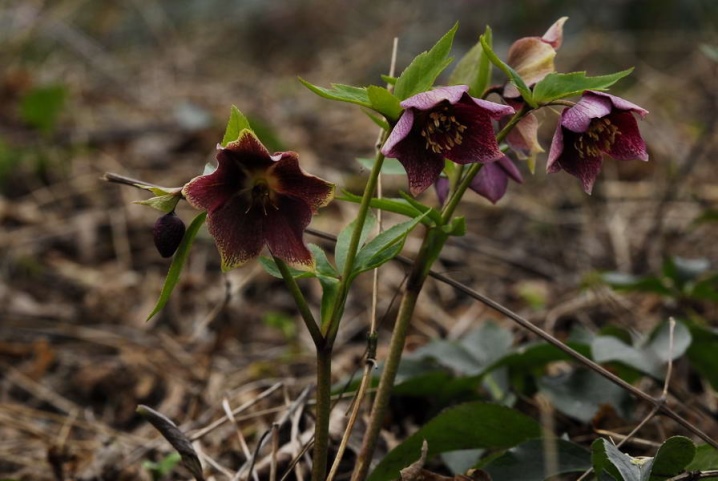
Hybrid
Helleborus Hubridus - this name should be understood as an amalgamation of hybrid varieties with a varied color of flowers - white, greenish-yellow, violet, lavender, deep purple. Most often, hybrid varieties have a high shrub size - up to 50 cm. These species are able to maintain leaves even in winter. The structure of the flowers is simple or double.
The most common hybrid hellebore species are Helleborus Winterbells, Helleborus Aubrieta, Helleborus Violetta, Helleborus Belinda, and so on.
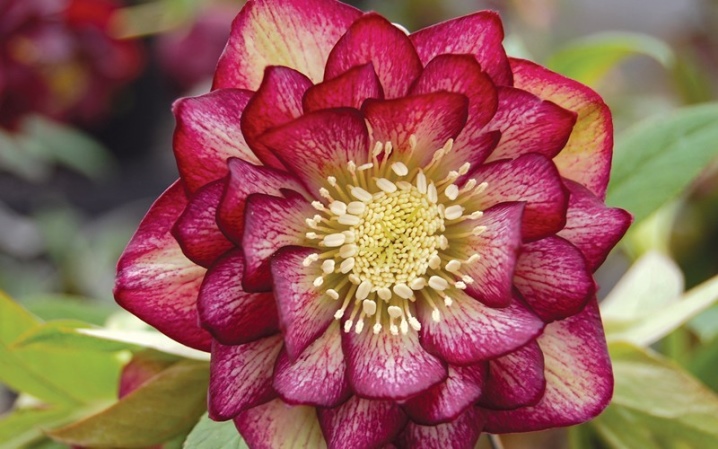
Landing
The hellebore can be grown as a home potted plant or planted outdoors. The most attractive herbaceous bushes of this perennial look when placed singly or in small groups of 2-3 plants.
The place for planting must be chosen thoughtfully and responsibly, since the plant tolerates transplants very poorly and may die for this reason.

Timing
In the open field, the hellebore is planted in the form of seedlings or by dividing the bush. This procedure is performed in mid-spring, that is, in April, or in autumn no later than September.

To grow a plant from seeds, they are collected from faded specimens in early July and immediately planted for germination. The germination rate of fresh planting material is good, and you will have young plants by March, next year. After the appearance of several pairs of leaves, the hellebore is transferred to the flower garden by picking.In a shaded place, flower seedlings will grow and develop for 2-3 years, after which they can be finally transplanted in September or April to a permanent place.

Technology
Growing a hellebore is not difficult - it is important to choose a location with a neutral soil pH and good drainage. The plant loves loose substrates, but it can also grow on loams if mixed with humus. You can plant this perennial between trees and shrubs, but the hellebore does not like the neighborhood with conifers.

The success of cultivating a hellebore in the garden depends on how correctly the technology of its planting is performed:
- the landing hole should be made about 30x30 cm, its depth should also be at least 30 cm;
- the distance between herbaceous bushes should be kept within 25-30 cm from each other;
- compost is poured into the hole at half its height, on which the seedling is placed;
- when placing a plant in a hole, the soil after planting is well compacted and watered abundantly.

In order for the plant to take root well, after planting it must be watered every day. This rule must be observed for at least a month, and it is especially important to monitor soil moisture if hot weather is established. Sometimes watering has to be done twice a day - in the morning and in the evening.

Subtleties of care
After planting, in the case when a hot air temperature is set, the hellebore should be watered regularly and do not forget to remove the weeds around it. After watering, the soil must be loosened every time. Twice in each season, the perennial must be fed with complex mineral fertilizers. After the snow melts in the spring, the hellebore needs to remove all last year's leaves, such a measure will prevent the development of a fungal infection that develops in a humid and cool environment. For the same purpose, it is required to remove wilted peduncles in a timely manner. After performing such a manipulation, the ground around the flower is loosened and mulched.


- Watering. Despite the fact that the perennial hellebore is considered a fairly hardy plant that can survive the lack of moisture for some time, this plant still needs to be watered regularly. The ideal option for this flower is constantly moist soil near it, however, waterlogging should be avoided when watering.

- Top dressing. With the arrival of spring, it is advisable to apply a complex mineral fertilizer to the plant, consisting of nitrogen, phosphorus and potassium. Further, as already mentioned, feeding is carried out twice a season. The plant will do well if the soil around it is renewed with fresh compost every year.

- Pruning. In early spring, a hellebore bush of any age must be rejuvenated by cutting off its aerial part. After such a procedure, the leaves and peduncles quickly grow back, and the flowering of the hellebore will be abundant. Pruning for the hellebore is also necessary from the point of view of protecting it from diseases that can be triggered by dying leaves and peduncles.

- Transfer. You can transplant the hellebore by dividing the bush, but it should be remembered that the plant does not always tolerate this manipulation safely - sometimes it dies or refuses to bloom. The transplant is done in the spring or autumn, during flowering, the manipulation is not carried out. The transplant is carried out as follows: the bush is dug up, the rhizome is divided into 2-3 parts, the cuts are powdered with crushed charcoal, and the resulting cuttings are seated in a new place in prepared planting holes.

Reproduction methods
This perennial can be propagated by germinating its seeds or dividing an adult bush. Planting material - seeds and young seedlings, can be purchased in specialized nurseries or use your own plants in order to increase their number in the flowerbed. Experienced growers believe that hellebore propagates best by seed. Some varieties require preliminary germination of seeds in greenhouses, while other species, for example, the Caucasian hellebore, are capable of self-sowing propagation.

Diseases and pests
A herbaceous shrub has the property of resisting diseases and the invasion of insect pests, but if you violate the basic principles of caring for this plant or plant it in acidified soils, it can get sick. Hellebore leaves love to eat slugs, snails and even mice. To combat them, garden insecticides are used.

It often happens that a perennial is affected by spotting, rot, powdery mildew, aphids or thrips. - this happens if the wilted foliage and flower stalks are not removed in time. To get rid of these misfortunes, the affected areas of the plant are cut off and removed, and the soil around the hellebore and the remaining healthy part is sprayed with solutions of fungicidal agents.
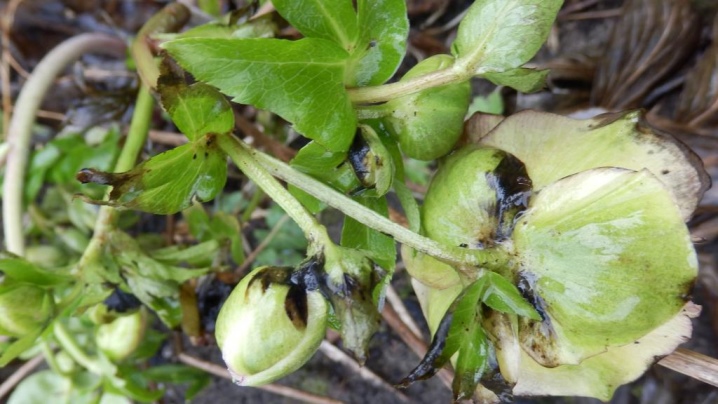
Use in landscape design
Gardeners grow hybrid varieties of hellebore in the garden near the house or in the country. Lovers of this plant cultivate it even in flower pots placed on the balcony or terrace. The use of a perennial to decorate flower beds and flower beds is justified by the fact that the plant is unpretentious and does not require special attention to itself. The flower looks beautiful when planted in single groups with small flowering species that do not tend to actively grow.
In landscape design, you can decorate the feet of deciduous trees, shrubs with a hellebore, plant them on an alpine slide, in a rockery, place them in groups near an artificial reservoir or near a fountain.
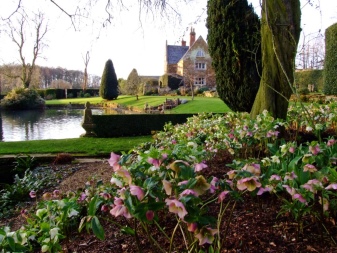

Reviews
Most flower growers agree that hybrid varieties of hellebore are very effective and unpretentious plants that, with their flowering, are able to open the summer season and do not need excessive care. These perennials deserve attention. Their white, purple, pale pink, yellow-green flowers, combined with spectacular emerald green foliage, can decorate any flower garden.

In the next video, you can watch the processes of division and transplantation of the hellebore.







































































































The comment was sent successfully.